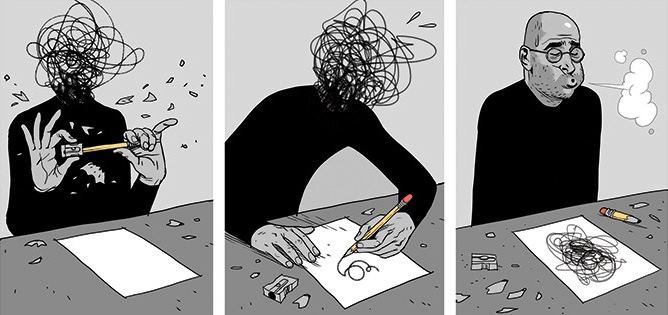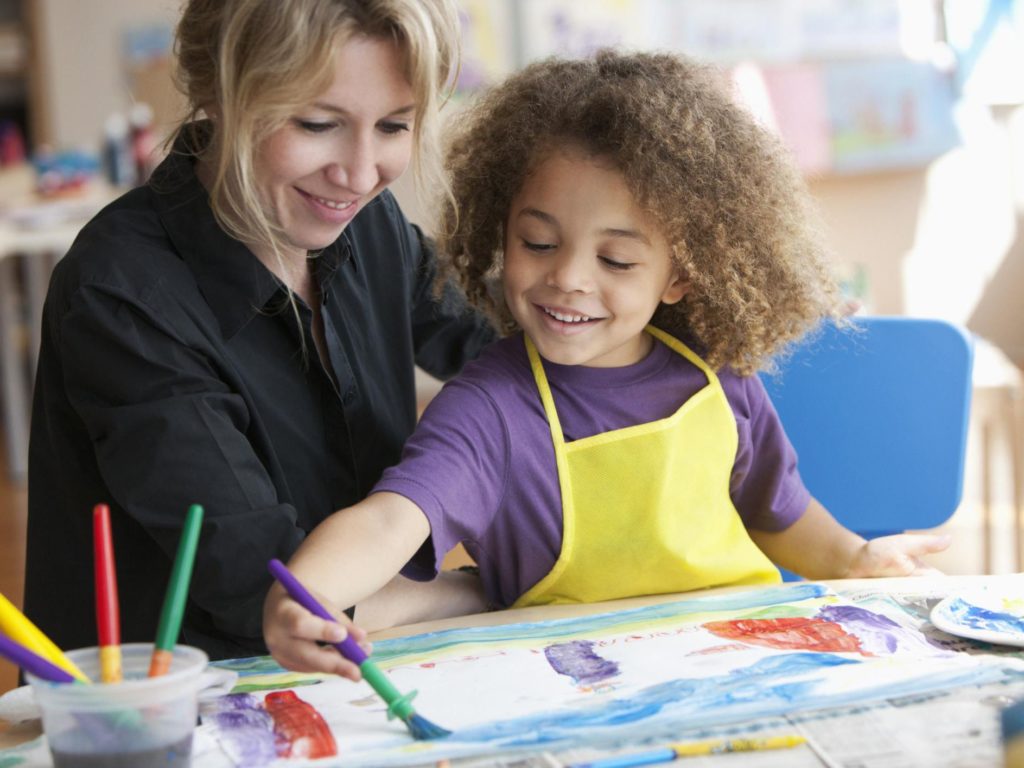According to the American Art Therapy Association, art therapy is “an established mental health profession that uses the creative process of art making to improve and enhance the physical, mental, and emotional well-being of individuals of all ages.” But how exactly does it work? Project Lyme recently spoke with Kristen L Vesbach MS, ATR-L, BC. , a skilled art therapist, to get the full scoop—including why art therapy is particularly useful for patients with conditions like Lyme disease or chronic illness. Here’s what Vesbach had to say:

What is art therapy?
Art therapy is a mental health profession. It’s a newer discipline that hasn’t been around that long, and it combines the fields of psychology and visual art. It involves working with an art therapist to create art together while processing your emotions and honoring your experiences.
You can use a variety of materials when you’re making art in art therapy, and you don’t have to consider yourself an artist. That’s a big misconception. I think that a lot of people are initially intimidated until they are able to realize that anything they make is OK. And then there’s the relationship between the art therapist, the art, and the client that helps provide that safety for people to really explore and honor their emotions and their experience. It’s integrative, so the mind, body, and senses are involved in the process.
Art therapists are trained to recognize non-verbal symbols within the art. A lot of times, it’s hard for people to express their feelings with words alone. So the art really helps that. And then the art therapist also helps you process and understand what the art might mean to you after you make something together. In art therapy, the art becomes a visible, visual representation of your thoughts and feelings, and that aids in self-awareness and self-discovery.
Why should people who are chronically sick or have Lyme disease try art therapy?
Art therapy can offer many benefits. The first one is just communication and self-expression. A lot of times when you’re sick and you’ve been sick for a long time, it’s really hard to express that pain and what you’re experiencing. I think a lot of times you lose your voice, and you kind of become your illness, because it’s become a part of you, and you’re trying to work through that. Art can help you not just access and express the emotions that come along with chronic illness, such as anxiety, shame, grief, and fears about treatment, but it can also help you to communicate with your health team what’s going on.
If we’re looking at the Lyme connection, a lot of times, it’s an invisible illness, and it takes a while for people to get to a point where they get treatment or know that they have Lyme disease. And I think that being able to use art to help them find their identity again is really important. So, communication, self-expression… it also aids in autonomy and empowerment. When you are using art, and you’re working with an art therapist, you get to make the choices. You get to decide: What color am I going to use? What am I going to make today? What symbols am I going to use? What do I want to work on? It’s an experience that engages all your senses, and you get to make a decision, and sometimes with chronic illness, you don’t always have choices, so it can be empowering that way.
How does art therapy help with chronic illness or Lyme disease?
Art therapy can be a mindful way to calm the nervous system and create safety. Art making is essentially a healing process that way. Especially working with an art therapist, you have that relationship, but it can be very meditative when you’re working, and you have that healthy distraction as you’re making something and you’re learning something new. It also engages both sides of your brain. So there’s that neuro connection too, if we’re looking at managing pain. You’re creating new pathways by engaging both sides of your brain, and you’re working with materials that can help you to reduce rumination as well.
And then the last thing is to reconnect and find meaning. Reconnecting with yourself after being sick, maybe for a long time. Or not being heard, not being seen. Maybe you’re being told that you look fine, or your tests are normal. I think that you get to gain the confidence and mastery of learning something new and then having an outlet for yourself creatively.
What kind of art might patients engage in during art therapy?
A lot of people just think drawing and painting. And usually you start out there, because drawing is a bit more controlled. Painting is a little less controlled. So, usually, you start out with more controlled mediums, because it gives a bit more safety than, say, paint, which is really messy. But there are lots of different mediums: clay, collage, sculpting, and I like to use writing with my clients. Sometimes we might bridge over into writing a story or poetry. So it doesn’t always have to be visual arts. I bring in a lot of mind and body work, so understanding, okay, what’s happening in your body right now? Can you notice what that might look like if you were to choose an art medium to express it with? Movement can also be involved.
What got you started with art therapy?
I was a very quiet, sensitive kid who wanted to be outside all the time. And I have always been making something for as long as I can remember. It was hard for me to articulate what I was feeling, maybe what I was experiencing, so I was always drawn to art as a way to do that. And I felt like when I did that, oh, I get myself. This makes sense to me. So I went to school for psychology and kept doing my art and was able to learn that there was a field called art therapy. And then I went down that path of getting my master’s degree and continuing down that road.
Do you have to be an artist to get something out of art therapy?
Absolutely not. There are so many aha moments in art. And when I work with people, oftentimes, unless they’re already an artist, they start out uncertain about making art, because they lost that playfulness that they had as a child, even if they were creative as a child. And so art therapy is helping them find that again and realize that they still have it.
Also, a lot of times, people don’t realize the process is almost as important, maybe even more so, than the products they make. Even if they consider it “ugly” art, the process of making it is where they really get the insights. Symbols tend to come up in the art, and oftentimes I think they realize they develop a lot of confidence in themselves. They start to think, “Oh, I can do this. I can learn something new.” And they feel less intimidated. They feel more self-aware. I think, too, they feel seen and heard, and that’s really awesome to witness.
What are some benefits of art therapy for the chronically sick?
First off, staying in tune with their mind and body. I have found as I’ve gone through my own treatment, a lot of times you’re so overwhelmed by symptoms that it’s hard to explain what’s bothering you. So art helps with being able to kind of map out visually where in your body things are hurting, or maybe even where they’re feeling better—because sometimes we miss how we are improving. By doing some visual journaling and actually mapping out like a little figure where in my body it’s hurting, that has been really helpful personally for me in my life’s journey. For instance, I have pages of progress, but also setbacks; it has helped me create a timeline of my story. I think if things are dismissed early on in treatment or if people don’t have the resources they need, it’s helpful to honor that: “This is my truth. This is really happening to me.”
What’s an example of an art therapy exercise you use with patients?
Oftentimes, I’ll have people create something called an “anger creature.” It’s this three-part process that can be really insightful, because, especially with chronic illness, I think people don’t know how to express anger in healthy ways. That can be really hard to work through in the context of your illness. So, they get to draw a creature that represents what their anger looks like. What happens with their anger? Does it go inward? Does it go outward? It gives them a chance to explore how they handle anger, and what that looks like for them, through this creature. And then I actually have them sculpt it out eventually. So it’s like they’re making this drawing to get to know their anger, and then they’re creating it. And it’s some sort of sculpture, maybe with clay or paper mâché, whatever they would like. And then they get to tell their story from their creature’s perspective, which is really kind of cool. It’s a great way for them to feel heard, and they have this symbol that gets to represent their anger, which feels safe for them.
And besides anger, what other emotions do you address frequently in art therapy?
Grief and shame. Shame is a big one because, especially with Lyme, people feel confused, like, “Why aren’t I getting better? I look fine. I’m being told I’m OK.” So there’s a lot of this with Lyme disease—and with other chronic illnesses too. And then grief, obviously, because you miss out on things when you’re sick, and you go through a lot of stages of feeling a little better and then flaring up and not feeling good again. And with that chronic up and down, you miss out on things, and you have to go through that grief and loss processing too. Then there’s fear. We can’t gloss over it: Fear of treatment and relapsed symptoms plays into it as well.
How can someone find a qualified art therapist?
Art therapy is practiced by a registered art therapist (ATR) or board-certified art therapist (ATR-BC) who has earned a master’s degree approved by the American Art Therapy association and has had supervision in the field.
Art therapists can be found on the following resources:
AATA directory: https://arttherapy.org/art-therapist-locator/
Psychology Today Therapist Directory (search under “art therapy” and look for a provider with ATR, ATR-L, or ATR-BC credentials): https://www.psychologytoday.com/us/therapists/
For those that are nervous about seeking treatment or cannot access an art therapist, creating art for self-expression can still be a form of self-care.
Here are some ideas to encourage your creativity:
Visual journaling — Use a journal to record your experiences by writing, drawing, or collecting small objects such as dried flowers or magazine clippings. This process can help you to check in with yourself and gain insight into your daily life. Lines, shapes, colors, scribbles, patterns, symbols, quotes, poetry, or even the leaf that you found on a stroll may find a way into your visual journal.
Drawing — Drawing with pencils, crayons or markers can be a great way to unwind and let your brain and body relax. Doodles are great and a fun way to be in the moment and allow for self-reflection and self-expression.
Collage — A collage can also be a very simple and rewarding method to help you process your thoughts and emotions and create a visual mind map. It is always interesting to see how the symbols come together.
For more information about Kristen L Vesbach MS, ATR-L, BC. , visit her website: https://www.abrushwithhope.com/




